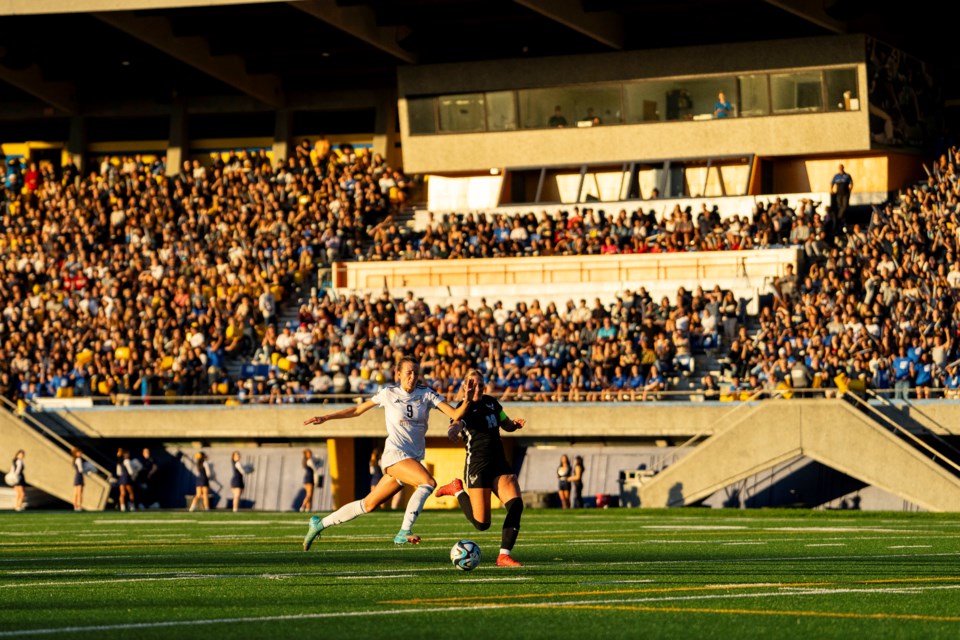University sports programs in B.C. are growing heavily reliant on other sources of revenue amidst international student caps.
In July 2024, the provincial government imposed international student caps across the province’s post-secondary institutions, limiting the population share of international students to 30 per cent of the total student body.
International student numbers have decreased across some of the province’s biggest universities, and in some cases, triggered a decline in tuition revenue.
Mixed with already tight financial constraints, this could pose a risk to some athletics programs in B.C., who are increasingly dependent on diversifying their revenues.
One of the biggest challenges faced by B.C. university sports programs is funding, University of British Columbia (UBC) Athletics and Recreation managing director Kavie Toor told BIV.
This, exacerbated by a decline in student tuition, means some institutions will have to lean more on the fundraising and business venture side of their athletics programs.
Every year, UBC’s athletics generates around $5 million from donations and around $20 million from business revenue, which includes events such as concerts and fitness camps.
“For us, I draw a direct line from that success to our competitive success,” he said. “Some schools will be needing to lean into the fundraising component more than ever, because I don’t think the funding from universities or student fees is going to increase.”
Then there’s the challenge of ensuring growth and relevance—making sure that athletics and recreation deliver the university’s mission.
“If you’re not relevant and you’re not aligned, there is definitely risk—not at our school—but there’s risk across the country of programs getting cut,” said Toor.
According to UBC’s 2024-25 budget, undergraduate international student numbers are projected to be 11,684 across both campuses—a decline of 207 students or 1.7 per cent since the previous school year.
Over the last three years, international student numbers have dropped by 499 or about 4.1 per cent.
Despite this decline, international tuition, including tuition for graduate students, has increased to a projected $662 million for this year, up by $28 million (4.4 per cent) from last year mainly due to tuition rate increases.
Tuition increases were three per cent for current international students and five per cent for new students.
Cost challenges have been more noticeable at smaller schools, such as the University of Victoria (UVic).
This school year, the university forecasts a total of 1,426 international undergraduate students, according to a November 2024 UVIC enrollment report—a decrease of 161 (10.1 per cent) since last year.
Over the last three years, international undergraduate student numbers have decreased by 481 (25 per cent).
International undergraduate tuition this year is projected to be around $40.2 million, or 25 per cent of the total $160.8 million student tuition. Projections for 2022-23 in that year’s budget showed around $65 million in international undergraduate tuition, or 37 per cent of the total $175.8 million in student tuition.
Based on the budgets, this represents a projected decrease of approximately 38.2 per cent in international undergraduate student tuition and 8.5 per cent in total tuition in a single year.
UVIC director of varsity performance sport Julianne Zussman, wrote in an email that despite financial challenges, the university’s department of athletics, recreation and wellness (has been able to maintain a strong foundation in sports programs.
This is done by using a diversified funding model blending funding from the university, self-generated revenues and donations.
“Our priority is to sustain all existing varsity programs,” she said. “We continue to explore innovative ways to enhance financial sustainability without compromising opportunities for our student-athletes.”
However, there’s been a growing reliance on donor support and fundraising efforts to remain at the highest level—like many other universities in Canada.
Other increasingly significant challenges include rising travel costs, equipment expenses and coaching salaries, which further require financial stability and grow reliance on diverse revenue sources, added Zussman.
Foreign recruitment and local attendance increases
Fiscal challenges intersect with two significant trends in university sports, one being an increase of student attendance at varsity games.
“They’re increasingly getting more connection and pride in their sports program. I think that’s been a shift.” said Toor. “Maybe even a decade ago, it was viewed as ancillary to the university.”
U Sports athlete recruitment from the National Collegiate Athletics Association (NCAA) has also been growing.
U Sports is the body overseeing sports across universities in Canada, with the NCAA overseeing sports in the U.S. and Simon Fraser University—the only Canadian school in this organization.
The success of sports programs in the province’s universities has exacerbated this interest, with several UBC athletes being recently drafted to the MLB, NFL and CFL.
“When you have these signings, all of a sudden, some U.S. schools take notice,” Toor said. “That’s certainly one trend that wasn’t the case even five years ago, where we’d see significant poaching, for lack of a better word.”
A main reason why foreign athletes could be attracted to join the NCAA is its increasing commercialization.
Name, Image and Likeness (NIL) was a policy introduced to the NCAA in 2021 which allows student athletes to profit off of their personal brand.
Commercialization is also facilitated through the NCAA’s transfer portal, which supports the transfer of student athletes between NCAA institutions, allowing athletes to move around schools for better deals.
People switching alliances and going to the highest bidder, feel antithetical to the true value “They do one year here, they switch there,” he said. “They’re popping all over the place because now there’s money to be made from collegiate sports in the U.S.”
This isn’t a bad thing entirely, he said, but added that the way it has been administered has turned out to be negative, with some players focused only on the highest bidder.



